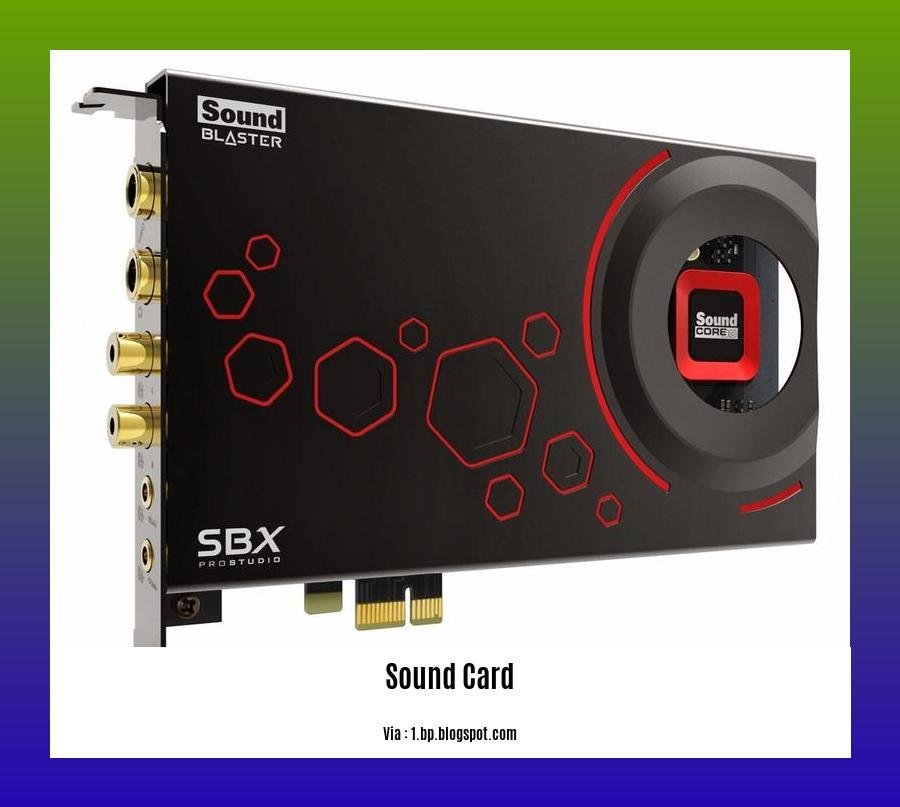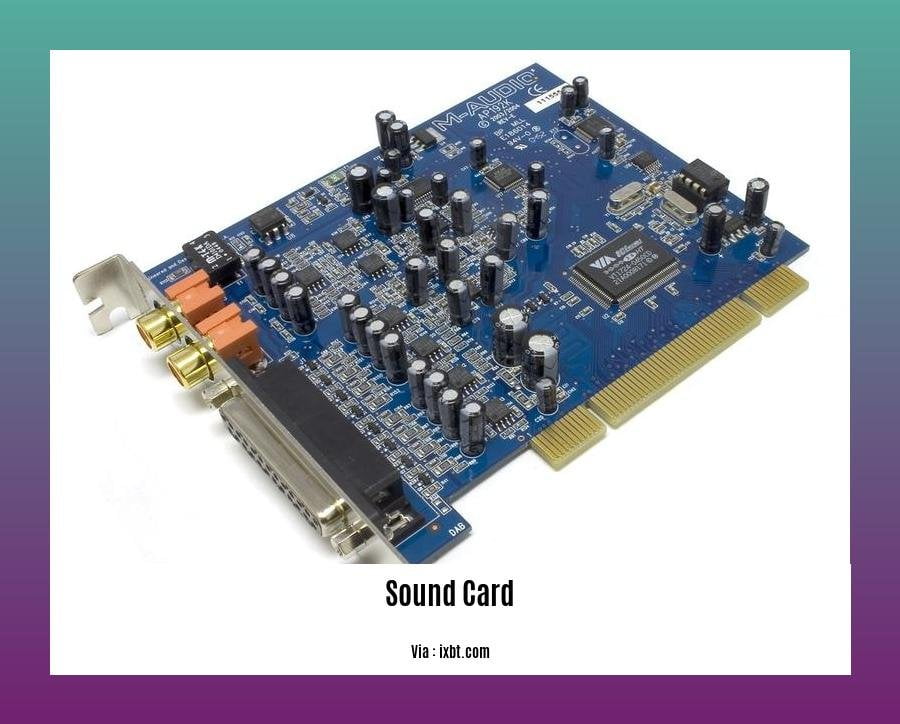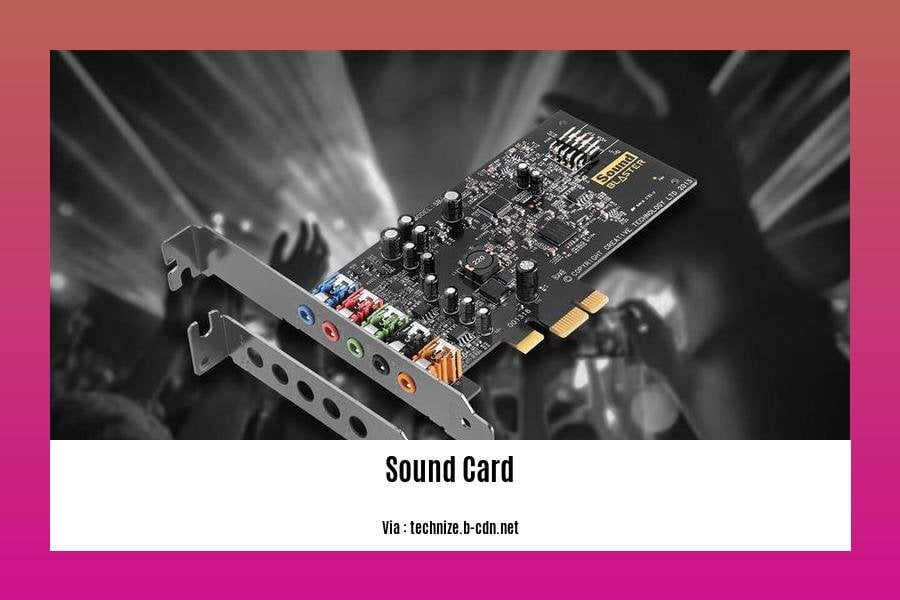Unlocking the Full Potential: Exploring the Benefits of a Sound Card for Enhanced Audio Experiences
In the world of audio engineering and music production, achieving optimal sound quality is of utmost importance. Seasoned professionals understand that the right equipment can make all the difference, and one essential tool for enhancing audio experiences is a sound card. With its ability to improve audio fidelity, reduce latency, and offer advanced connectivity options, a sound card plays a significant role in unlocking the full potential of any audio setup. In this article, we will delve into the various benefits of using a sound card and explore why it is an essential component for any discerning audio enthusiast.
Key Takeaways:
- Investing in a dedicated sound card can improve sound quality and enhance audio experiences.
- Sound cards are particularly useful when the built-in sound card of a computer is inferior to other devices.
- External sound cards offer even better quality with features like lower noise, more detail, and a better soundstage.
- Dedicated sound cards provide additional features such as higher signal-to-noise ratios, lower harmonic distortion, and higher sample rates.
- Informative sources like “Discover How Sound Cards Enhance Your Audio Experience” and “Features, function, and Advantages of sound card” discuss the benefits and features of using a sound card.
- Sound cards offer better recording and editing capabilities and are compatible with high-end audio equipment.
- These additional features contribute to higher audio fidelity for a more immersive and detailed audio experience.
Unlocking the Full Potential: Exploring the Benefits of a Sound Card for Enhanced Audio Experiences

Investing in a dedicated sound card can significantly elevate your audio experience. Whether you are an audio engineer, music producer, or simply a music enthusiast, a sound card can bring a range of benefits that will enhance the quality and overall enjoyment of your audio playback, recording, and editing.
Improving Sound Quality
One of the key benefits of a sound card is its ability to enhance the sound quality of your computer’s audio output. While built-in sound cards may suffice for basic audio needs, they often lack the capability to produce high-quality audio. This is where dedicated sound cards shine. These external devices offer superior sound quality with features like lower noise levels, enhanced detail, and a more expansive soundstage, elevating your listening experience to a whole new level.
Dedicated sound cards come equipped with additional features that contribute to their ability to deliver exceptional audio fidelity. These features include higher signal-to-noise ratios, lower harmonic distortion, 24-bit sample rates, 192-kHz resolutions, and additional application programming interfaces (APIs). The combination of these features results in a more immersive and detailed audio experience, allowing you to fully appreciate the nuances and intricacies of the music you love.
Expanding Recording and Editing Capabilities
In addition to improving sound quality, sound cards also offer enhanced recording and editing capabilities. Unlike built-in sound cards that are often limited in their input options, dedicated sound cards provide a wider range of connectivity options, allowing you to connect a variety of external devices such as microphones, instruments, and audio interfaces.
This expanded connectivity enables you to capture audio with greater precision and control. Whether you are recording vocals, live instruments, or podcasts, dedicated sound cards offer higher quality analog-to-digital converters (ADCs) that translate the analog audio signals into digital data with greater accuracy. This ensures that every subtle detail and nuance of your recordings is faithfully captured, resulting in professional-grade audio recordings.
Furthermore, dedicated sound cards often come with advanced software suites that provide a host of powerful editing tools. These tools allow you to fine-tune your recordings, apply effects, and make precise adjustments to ensure your audio creations meet your desired standards.
Compatibility with High-End Audio Equipment
If you are a professional or an audiophile with a collection of high-end audio equipment, a dedicated sound card becomes even more essential. Sound cards are designed to be compatible with a wide range of audio devices, including studio monitors, headphones, amplifiers, and DACs (digital-to-analog converters). This compatibility ensures that you can fully utilize the capabilities of your high-end audio equipment and achieve the best possible audio performance.
By connecting your high-end audio devices to a dedicated sound card, you can take advantage of their premium sound quality, allowing you to experience music and audio in its purest form. Whether you are mixing tracks in a studio or simply enjoying your favorite songs at home, the compatibility between sound cards and high-end audio equipment ensures that you are getting the most out of your investments.
Conclusion
Investing in a dedicated sound card offers a multitude of benefits for both audio professionals and enthusiasts alike. The benefits of a sound card include improved sound quality, expanded recording and editing capabilities, and compatibility with high-end audio equipment. These features contribute to a more immersive and detailed audio experience, allowing you to unlock the full potential of your audio content.
So, whether you are a music producer striving for impeccable sound quality, an audio engineer looking for precise recording and editing tools, or a music lover seeking the best possible audio experience, a dedicated sound card is an essential investment that can transform your audio experiences and elevate them to new heights.
Sources:
– Discover How Sound Cards Enhance Your Audio Experience
– Features, Function, and Advantages of Sound Card
Looking for the best city for part-time jobs in Canada? Check out our list of cities with excellent opportunities: best city for part time jobs in canada.
If you’re interested in construction jobs, we’ve got you covered! Discover the best city in Canada for construction jobs here: best city in canada for construction jobs.
Planning a bachelor party in Alberta? We have some amazing ideas to make it an unforgettable celebration! Explore our top recommendations for bachelor party ideas in Alberta: bachelor party ideas alberta.
Looking for bachelor party ideas in Canada? Look no further! We have a variety of exciting options to make your bachelor party an epic experience: bachelor party ideas canada.
Outline 3: Reduced Latency and Improved Audio Performance
Audio Latency and the Importance of Audio Interfaces
Audio latency is a crucial concern in digital audio production, as it can impact real-time monitoring, recording, and overall audio quality. Latency refers to the delay between the production of a sound signal and its playback. In a digital audio system, this delay occurs when a sound signal travels through the system and encounters factors such as buffering and analog-to-digital (ADC) and digital-to-analog (DAC) conversion processes. While latency is unavoidable, excessive latency can be problematic for audio production, especially in live monitoring or real-time processing scenarios.
How Audio Interfaces Reduce Latency
Audio interfaces play a significant role in reducing latency and improving the overall performance of a digital audio system. Unlike a computer’s built-in sound card, which often lacks the capability to produce high-quality audio, dedicated audio interfaces offer better latency performance. They do this by providing dedicated ADC and DAC units, as well as efficient drivers. The use of specialized hardware and software in audio interfaces helps minimize latency and enhances the audio production experience.
MIDI Latency
In addition to audio latency, digital audio systems also face MIDI latency issues. MIDI information, used for music production and control, can experience delays during transmission. Addressing MIDI latency requires the use of optimized MIDI interfaces and configuration settings.
Choosing the Right Audio Interface
To achieve reduced latency and improved audio performance, it is recommended to use high-quality audio interfaces specifically designed for music production. These audio interfaces offer a variety of connection types, allowing users to choose the option that best suits their system’s latency needs. Some well-regarded options include the Focusrite Scarlett 4i4, Behringer U-Phoria UMC404HD, Steinberg UR22mkII USB Audio Interface, Universal Audio Apollo Twin X DUO 10×6 Thunderbolt Audio Interface, and Native Instruments Komplete Audio 6 Mk2 USB Audio Interface.
Key Takeaways:
- Audio latency refers to the delay between the production of a sound signal and its playback in a digital audio system.
- Factors such as buffering and ADC/DAC conversion contribute to latency in digital audio systems.
- Excessive latency can negatively impact real-time monitoring, recording, and overall audio quality.
- Audio interfaces offer dedicated ADC and DAC units and efficient drivers, which help reduce latency compared to built-in sound cards.
- MIDI latency is also a concern in digital audio systems and can be addressed with optimized MIDI interfaces and configuration settings.
- Choosing a high-quality audio interface designed for music production can significantly reduce latency and improve audio performance.
Sources:
– Why Audio Latency Matters And How An Audio Interface Can Help
– Best Sound Cards for High-Quality Music Production in 2023 – Audio Assemble
Outline 4: Advanced Connectivity Options Offered by Sound Cards

Audio engineers and music producers understand the critical role that sound cards play in achieving optimal audio experiences. Sound cards not only enhance sound quality but also provide advanced connectivity options for recording and playback. In this article, we will explore the benefits of sound cards’ advanced connectivity options, enabling users to connect various devices and instruments for enhanced audio production.
Connecting Microphones and Recording Audio
One of the primary advantages of sound cards is their input ports for microphones. These input ports allow users to connect microphones directly to their sound card, enabling high-quality audio recording. This feature makes sound cards particularly popular among podcasters, audio recordists, and those engaged in professional audio production. The ability to connect microphones directly to the sound card ensures improved sound quality compared to using a computer’s built-in sound card.
Enhancing Sound Quality and Connectivity
Sound cards significantly improve the quality of audio produced by devices that don’t have built-in sound cards. External sound cards, in particular, offer even better audio quality, thanks to their advanced components and circuitry. They often feature additional options such as equalization, surround sound, and noise reduction, providing users with more control over the audio they produce. Whether it’s for music production, gaming, or audio editing, the advanced connectivity options offered by sound cards enhance the overall sound quality and connectivity of your system.
Compatibility with Audio Devices and Instruments
Another advantage of sound cards is their compatibility with a wide range of audio devices and musical instruments. With a sound card, you can connect any instrument or audio device to your computer and produce the best audio possible. This enhances versatility, allowing users to work with different audio inputs and outputs, including MIDI devices, amplifiers, studio monitors, headphones, and DACs (digital-to-analog converters). Sound cards ensure seamless compatibility, maximizing the performance of these devices and offering a comprehensive audio production setup.
For Audio Professionals and Audiophiles
While sound cards may not be necessary for most users, they are especially valuable for audiovisual professionals and audiophile enthusiasts. Investing in a dedicated sound card provides better support for audio, unlocks more audio options, and enhances audio processing. Features like lower noise levels, enhanced detail, and a more expansive soundstage contribute to a more immersive and detailed audio experience. Additionally, sound cards often come with advanced software suites that offer powerful editing tools for precise adjustments and fine-tuning of audio recordings.
Key Takeaways:
- Sound cards provide advanced connectivity options for audio recording and playback.
- They come equipped with input ports for microphones, facilitating high-quality audio recording.
- Sound cards enhance the sound quality of devices compared to those without built-in sound cards.
- External sound cards offer even better audio quality with additional features like equalization and noise reduction.
- Sound cards are compatible with various audio devices and instruments, providing versatility in audio production.
- While not necessary for most users, sound cards are valuable for audio professionals and audiophile enthusiasts, enhancing sound quality and offering advanced editing capabilities.
Sources:
– Lola App. “Advantages and Disadvantages of Sound Card.” Lola App.
– Know Computing. “Features, Function, and Advantages of Sound Card.” Know Computing.
Unlocking the Full Potential: Exploring the Benefits of a Sound Card for Enhanced Audio Experiences
Key Takeaways:
– Sound cards offer advanced connectivity options for enhanced audio recording and playback.
– They come equipped with input ports for microphones, allowing users to record audio, making them popular for creating podcasts and audio recordings.
– Sound cards improve the quality of audio produced by devices compared to if they don’t have them.
– External sound cards offer even better audio quality.
– Sound cards often come with additional features such as equalization, surround sound, and noise reduction, giving users more control over the audio they produce.
– Sound cards are compatible with a variety of audio devices and musical instruments, allowing users to use any instrument to produce the best audio.
– Generally, modern sound cards are worth it for audiovisual professionals or audiophile enthusiasts, but may not be necessary for most other users.
– Sound cards provide better support for audio, allowing for more audio options and enhanced audio processing.
– Some users may benefit from the improved audio quality that a sound card provides.
– Sound cards have ports that allow for audio input and output, including microphone and speaker ports.
– Sound cards enhance the sound quality that the system produces.
– Adding a sound card can improve the overall audio experience and provide better compatibility with audio devices.
– Sound cards can be beneficial for those who require high-quality audio for professional purposes or have specific audio needs.
Audio technology has come a long way, revolutionizing the way we experience sound. Whether you are a professional audio engineer, a music producer, or an avid gamer, achieving the optimal audio experience is a top priority. That’s where sound cards come into play. In this article, we will explore the benefits of sound cards, understanding their significance in enhancing audio fidelity, reducing latency, and providing advanced connectivity options.
Immersive Surround Sound and Enhanced Speaker Systems
One of the key advantages of sound cards is their ability to support more audio channels, such as 5.1 and 7.1 surround sound. This allows for a more immersive audio experience, especially when paired with high-quality speaker systems. You’ll feel like you’re right in the middle of the action, with sounds coming from different directions, enveloping you in a three-dimensional audio environment.
Improved Microphone Quality
For those involved in recording audio, whether it be voiceovers, podcasts, or music, the quality of the microphone is of utmost importance. Sound cards can significantly enhance the performance of microphones, resulting in better sound reproduction and clarity. This improvement is particularly noticeable when compared to using built-in sound cards, which often lack the necessary features to produce high-quality audio.
Internal vs. External Sound Cards
Sound cards come in two main types: internal and external. Internal sound cards are installed inside your computer and connect directly to the motherboard via a PCIe slot. On the other hand, external sound cards connect to your computer via USB ports.
When it comes to sound quality, external sound cards generally offer superior performance due to their ability to reduce interference from internal components. They also provide more flexibility as they can be easily connected to different devices.
Considerations When Choosing a Sound Card
Choosing the right sound card can be a daunting task, with various factors to consider. Here are some key recommendations and considerations:
Audio Channels: Look for sound cards that support the desired number of audio channels for your specific needs. If you are into gaming or audio production, options like 5.1 or 7.1 surround sound capability would be ideal for an immersive experience.
Bit Depth and Sample Rate: Pay attention to the bit depth and sample rate specifications of the sound card. Higher values indicate better audio quality and fidelity.
Signal-to-Noise Ratio: A higher signal-to-noise ratio (SNR) is desirable, as it ensures a cleaner audio signal with minimized background noise.
Connectivity Options: Consider the connectivity options provided by the sound card. Look for the necessary input and output ports to support your specific audio setup. This includes microphone and speaker ports, as well as support for external devices such as instruments and audio interfaces.
Budget: Set a budget and research different sound card options within that range. Prices can vary depending on the brand, model, and features offered. Find a balance between your requirements and affordability.
Conclusion
It’s clear that sound cards play a significant role in achieving optimal audio experiences. With advanced connectivity options, improved microphone quality, and enhanced audio processing capabilities, sound cards are a valuable addition to any audio setup. Whether you are a professional in the audiovisual industry or an enthusiast seeking high-quality audio, investing in a dedicated sound card can unlock the full potential of your audio system.
Sources:
– Make Tech Easier
– Cybersided
FAQ
Q1: How do sound cards contribute to better audio quality?
A1: Sound cards enhance the quality of audio produced by devices compared to if they don’t have a dedicated sound card. External sound cards, in particular, offer even better quality with features like lower noise, more detail, and a better soundstage.
Q2: What additional features do sound cards provide for audio recordings?
A2: Sound cards offer advanced connectivity options for enhanced audio recording and playback. They come equipped with input ports for microphones, allowing users to record audio, making them popular for creating podcasts and audio recordings.
Q3: Do sound cards have compatibility with different audio devices and instruments?
A3: Yes, sound cards are compatible with a variety of audio devices and musical instruments, allowing users to use any instrument to produce the best audio.
Q4: Are sound cards worth it for all users or only professionals?
A4: Generally, modern sound cards are worth it for audiovisual professionals or audiophile enthusiasts, but may not be necessary for most other users. However, some users may benefit from the improved audio quality that a sound card provides.
Q5: How do sound cards reduce audio latency?
A5: Sound cards, particularly those designed for music production, can significantly reduce audio latency by offering dedicated analog-to-digital (ADC) and digital-to-analog (DAC) units, efficient drivers, and a variety of connection types to suit different system latency needs.
- Unlocking Francis Alexander Shields’ Finance Empire: A Comprehensive Biography - July 12, 2025
- Unveiling Francis Alexander Shields: A Business Legacy - July 12, 2025
- Francis Alexander Shields’ Business Career: A Comprehensive Overview - July 12, 2025















